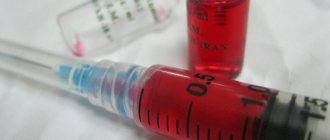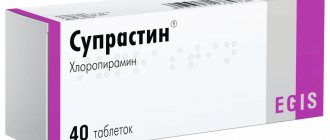Compound
The composition of 1 ml of Combilipen solution includes the following active ingredients: thiamine hydrochloride - 50 mg, pyridoxine hydrochloride - 50 mg, cyanocobalamin - 500 mcg, lidocaine hydrochloride - 10 mg.
As excipients: benzyl alcohol, sodium hydroxide, potassium hexacyanoferrate, sodium tripolyphosphate, water for injection. The composition of 1 tablet of the drug includes: pyridoxine hydrochloride - 100 mg, benfotiamine - 100 mg, cyanocobalamin - 2 mcg. As excipients: carmellose sodium, microcrystalline cellulose, povidone K30, calcium stearate, talc, polysorbate, sucrose.
Combilipen®
Thiamine
After intramuscular administration, thiamine is quickly absorbed from the injection site and enters the blood (484 ng/ml after 15 minutes on the first day of administration of a 50 mg dose) and is unevenly distributed in the body with its content in leukocytes 15%, erythrocytes 75% and in blood plasma 10 %. Due to the lack of significant reserves of the vitamin in the body, it must be supplied to the body daily.
Thiamine penetrates the blood-brain and placental barriers and is found in breast milk. Thiamine is excreted by the kidneys in the alpha phase after 0.15 hours, in the beta phase after 1 hour, and in the final (terminal) phase within 2 days. The main metabolites are: thiaminecarboxylic acid, pyramine and some unknown metabolites. Of all the vitamins, thiamine is stored in the body in the smallest quantities. The adult human body contains about 30 mg of thiamine: 80% in the form of thiamine pyrophosphate. 10% in the form of thiamine triphosphate and the rest in the form of thiamine monophosphate.
Pyridoxine
After intramuscular injection, pyridoxine is quickly absorbed from the injection site and distributed in the body, acting as a coenzyme after phosphorylation of the CH2OH group at the 5th position. About 80% of the vitamin binds to blood plasma proteins. Pyridoxine is distributed throughout the body, penetrates the placenta, and is found in breast milk. It accumulates in the liver and is oxidized to 4-pyridoxic acid, which is excreted by the kidneys within a maximum of 2-5 hours after absorption.
The human body contains 40-150 mg of vitamin B6 and its daily elimination rate is about 1.7-3.6 mg with a replacement rate of 2.2-2.4%.
Cyanocobalamin
Cyanocobalamin, after intramuscular administration, binds to transcobalamins I and II and is transported to various tissues of the body. The maximum concentration after intramuscular administration is achieved after 1 hour. Communication with blood plasma proteins - 90%. Penetrates the placental barrier and is found in breast milk. Metabolized primarily in the liver to form adenosylcobalamin, which is the active form of cyanocobalamin. It is deposited in the liver, enters the intestines with bile and is reabsorbed into the blood (the phenomenon of enterohepatic recirculation).
The half-life is long, excreted mainly by the kidneys (7-10%) and through the intestines (50%). With a decrease in renal function, 0-7% is excreted by the kidneys and 70-100% through the intestines.
Lidocaine
When administered intramuscularly, the maximum plasma concentration of lidocaine is observed 5-15 minutes after injection. Depending on the dose, about 60-80% of lidocaine is bound to plasma proteins. Quickly distributed (within 6-9 minutes) in organs and tissues with good perfusion, incl. heart, lungs, liver, kidneys, then in muscle and adipose tissue. Penetrates the blood-brain and placental barriers and is found in breast milk (up to 40% of the concentration in the mother's blood plasma).
Metabolized in the liver with the participation of microsomal enzymes with the formation of active metabolites - monoethylglycine xylide and glycine xylide. having a half-life of 2 and 10 hours, respectively. Metabolic intensity decreases in liver diseases. It is excreted mainly in the form of metabolites by the kidneys and up to 10% unchanged.
pharmachologic effect
The drug is a multivitamin complex, which includes several components.
Thiamine hydrochloride (vitamin B1) provides glucose to the body's nerve cells. Lack of glucose leads to deformation and subsequent enlargement of nerve cells, which ultimately provokes a violation of their immediate functions.
Pyridoxine hydrochloride (vitamin B6) is directly involved in the metabolic processes of the central nervous system. It ensures the normalization of the conduction of nerve impulses, excitation and inhibition, and also takes part in the synthesis of catecholamines ( adrenaline , norepinephrine ) and in the transport of sphingosine (a component of the nerve sheath).
Cyanocobalamin (vitamin B12) is involved in the production of choline, the main substrate for the synthesis of acetylcholine (acetylcholine is a neurotransmitter that takes part in the conduction of nerve impulses), hematopoiesis (promotes the maturation of red blood cells and ensures their resistance to hemolysis). Cyanocobalamin is also involved in the synthesis of nucleic acids , folic acid , and myelin . It increases the ability of body tissues to regenerate.
special instructions
During the therapeutic course, you should not simultaneously take other multivitamin complexes that contain B vitamins.
If injections or tablets are taken together with Levodopa, the effect of vitamin B6 on the human body is significantly reduced.
Before starting treatment, you need to consult a specialist. If treatment is carried out with Combilipen, then it is best to refrain from driving a vehicle and other dangerous mechanisms for the first time after taking it.
Indications for use of Kombilipen
Indications for the use of this drug are a number of neurological diseases:
- trigeminal neuralgia;
- inflammation of the facial nerve;
- polyneuropathy , which has different origins: diabetic and alcoholic;
- pain in patients suffering from spinal diseases: intercostal neuralgia , lumbar and cervical syndrome , cervicobrachial syndrome , radicular syndrome , pathological changes in the spine.
The price and reviews of the drug’s effect on the treatment of these diseases indicate its high effectiveness when used in complex therapy.
Instructions for use of Kombilipen (Method and dosage)
When using a solution of the drug, injections are given intramuscularly.
If the symptoms of the disease are pronounced, injections are carried out for 5-7 days, 2 ml daily, after which the administration of Combilipen continues 2-3 times a week for another two weeks.
For mild forms of the disease, injections are carried out 2-3 times a week for no more than 10 days. Treatment with Kombilipen solution is carried out for no more than two weeks, the dosage is adjusted by the attending physician.
Instructions for use of Combilipen Tabs tablets
The drug should be taken after meals, washed down with a small amount of water, and not chewed. Adult patients take 1-3 tablets daily. The course of treatment is prescribed by a specialist. High doses of the drug should not be taken for longer than four weeks.
Contraindications and adverse reactions
The instructions indicate cases in which you should refuse to take a multivitamin complex:
- increased susceptibility to constituent components;
- diseases of the cardiovascular system;
- the period of bearing a child and breastfeeding.
In some cases, negative manifestations may occur in the form of:
- heart rhythm disturbance;
- allergic manifestations (swelling, itching, urticaria);
- acne.
If such reactions occur, you should stop taking the drug and inform your doctor.
If you regularly exceed the permissible dosage, then signs of side effects may appear in an intensified form. Vomiting, nausea, and dizziness may also occur. If such symptoms occur, you should also stop taking the drug and begin symptomatic treatment.
Interaction
If Kombilipen injections or oral administration of the drug are combined with treatment with Levodopa, the effect of vitamin B6 .
You cannot inject medications with substances that have a redox effect, as they are incompatible with vitamin B1 . These are mercuric chloride , carbonate , iodide , acetate , tannic acid .
In addition, thiamine intake cannot be combined with sodium phenobarbital , riboflavin , metabisulfite , benzylpenylene , dextrose .
Thiamine is destroyed very quickly when in contact with copper. Thiamine inactivation also occurs when the pH exceeds 3.
Vitamin B12 is not compatible with heavy metal compounds.
Analogs
Level 4 ATX code matches:
Neurobex Forte
Neurobex
Milgamma Compositum
Milgamma
Neurorubin
Neurobion
Pharmacies sell analogues of Kombilipen, which contain similar active ingredients. There are a large number of multivitamin preparations that contain vitamins. The price of analogues varies widely. When choosing an analogue, you should take into account what Combilipen is and what vitamins are included in its composition.
Which is better: Milgamma or Combilipen?
The drugs Milgamma and Kombilipen are analogs and are manufactured by different manufacturers. Both drugs have a similar effect on the human body. However, the cost in Milgamma pharmacies is higher.
Reviews
Reviews for Combilipen are mostly positive. Patients note its beneficial effects in the complex treatment of various neurological diseases. Leaving reviews of injections and reviews on Combilipen Tabs, people note its affordable price.
Due to the presence of lidocaine in the composition, the injections are less painful than the injection of analogues containing B vitamins. Reviews of doctors about the tablets and solution of this drug indicate that it has a pronounced positive effect in the treatment of osteochondrosis . As adverse reactions, reviews mention the appearance of slight itching of the skin and urticaria.
How much does Combilipen cost?
A multivitamin complex can be purchased at a pharmacy. It is released only with a medical prescription. The injection solution costs an average of 230 rubles. The drug in tablet form is sold for 250 rubles.
In conclusion, it is worth noting that multivitamins are an excellent remedy that is effective for various diseases of the central nervous system. The medicine copes with diseases in mild and more complex forms. The constituent components are B vitamins, which provide undeniable benefits to the human body.
Price, where to buy
The average price for Combilipen in ampoules is about 350 rubles. (ampoules 2 ml, 10 pcs/). Price for ampoules in a package of 5 pcs. averages 150 rubles. In some pharmacy chains the price of Combilipen injections may be lower.
The medicine in tablet form is sold for an average of 300 rubles. (price of Combilipen Tabs tablets, 30 pieces per package). The drug in tablets (pack of 60 pieces) can be purchased at a price of 450 rubles.
- Online pharmacies in RussiaRussia
- Online pharmacies in KazakhstanKazakhstan
ZdravCity
- Combilipen tabs tab.
p.o n30 Pharmstandard-Ufavita Ufimsky vitamin plant OJSC 288 rub. order - Combilipen tabs tab. p.o n60Pharmstandard-Ufavita Ufimsky vitamin plant OJSC
RUB 477 order
Pharmacy Dialogue
- Combilipen Tabs (tab. No. 60) FS-UfaVita
476 rub. order
- Combilipen (amp. 2 ml No. 10) FS-UfaVita
417 RUR order
- Combilipen Tabs (tab. No. 30) FS-UfaVita
RUB 265 order
- Combilipen (amp. 2 ml No. 5) FS-UfaVita
155 rub. order
show more


